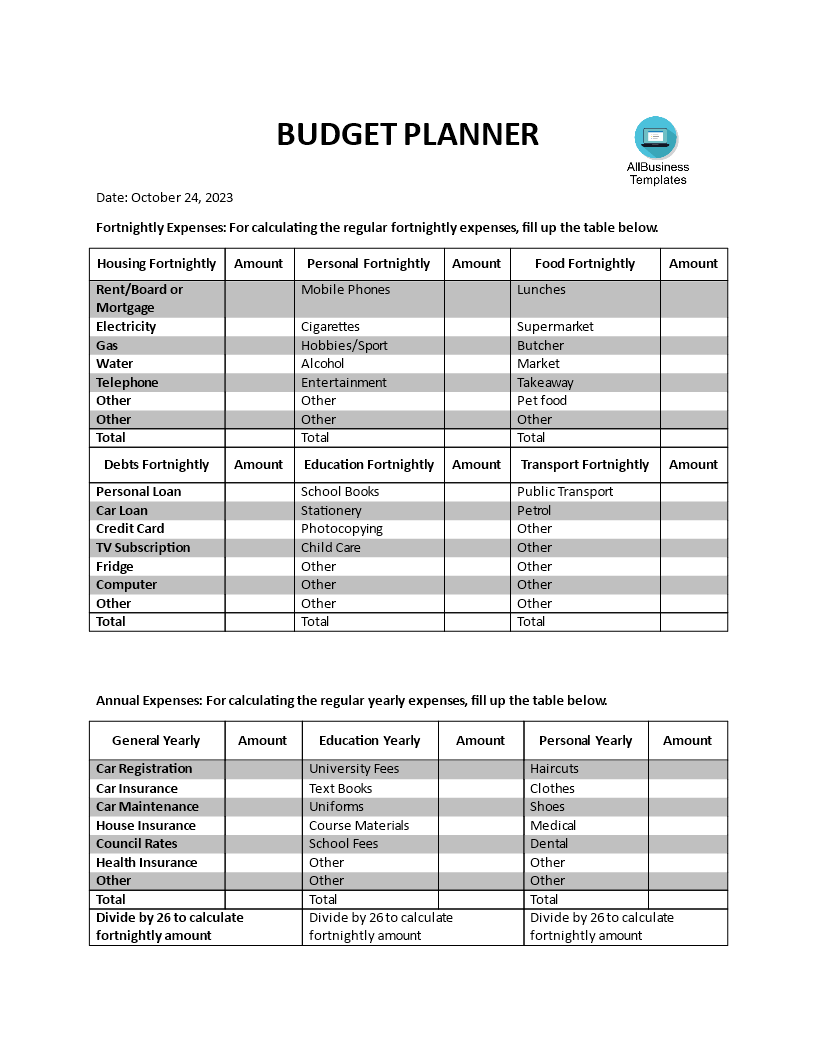Budget Planner Printable
Save, fill-In The Blanks, Print, Done!

Download Budget Planner Printable
Microsoft Word (.docx)Or select the format you want and we convert it for you for free:
Other languages available:
- This Document Has Been Certified by a Professional
- 100% customizable
- This is a digital download (33.33 kB)
- Language: English
- We recommend downloading this file onto your computer.
- Set Financial Goals: Begin by identifying specific financial objectives. These goals can include saving for a major purchase, reducing debt, increasing profits in a business, or allocating resources for public services in government.
- Gather Financial Data: Collect accurate and up-to-date financial information, including income sources, expenses, debts, assets, and liabilities. In business and government, historical financial data is often used to inform the budget.
- Create a Revenue (Income) Projection: Estimate all potential sources of income or revenue for the budget period. This includes salary, business income, investment returns, grants, taxes, and any other revenue streams.
- List Expenses: Identify and categorize all anticipated expenses, such as rent or mortgage payments, utilities, employee salaries, operating costs, interest payments on debts, and other financial obligations.
- Prioritize and Allocate Funds: Determine which expenses are essential and should be prioritized. Allocate funds to these critical expenses first. Consider creating categories for discretionary spending, savings, and investments.
- Estimate Future Expenses: For some expenses, such as utilities, insurance, and taxes, it's essential to estimate future costs based on historical data and expected changes.
- Account for Unexpected Expenses: Include a line item for contingency or emergency expenses. This will help you prepare for unexpected financial setbacks.
- Balance the Budget: Ensure that total projected income matches total projected expenses. If there is a surplus, allocate it to savings, investments, or paying down debt. If there is a deficit, reconsider expenses or look for additional sources of income.
- Monitor and Review: Regularly monitor actual income and expenses throughout the budget period and make adjustments as necessary to stay on track.
- Report and Communicate: In a business or government context, financial budgets are often shared with stakeholders or decision-makers to gain approval, provide transparency, and ensure accountability.
Feel free to download our basic or advanced budget templates, they are intuitive and in several kinds of formats, such as PDF, WORD, PPT, XLS (Budget Worksheet in Excel includes formulas and can calculate sums automatically), etc.
Using this printable Budget Planner guarantees that you will save time, cost, and effort and enables you to reach the next level of success in your project, education, work, and business! Download this Home Budget Planner Printable template now!
Looking for more? Our collection of financial documents, templates, forms, and spreadsheets includes templates designed specifically for small business owners, private individuals, or Finance Staff. Find financial projections to calculate your startup expenses, payroll costs, sales forecast, cash flow, income statement, balance sheet, break-even analysis, financial ratios, cost of goods sold, amortization, and depreciation for your company. These financial templates also work with OpenOffice and Google Spreadsheets, so if you are operating your business on a very tight budget, hopefully, you'll be able to make these financial templates work for you as well.
DISCLAIMER
Nothing on this site shall be considered legal advice and no attorney-client relationship is established.
Leave a Reply. If you have any questions or remarks, feel free to post them below.
Latest templates
Latest topics
- GDPR Compliance Templates
What do you need to become GDPR compliant? Are you looking for useful GDPR document templates to make you compliant? All these compliance documents will be available to download instantly... - Google Docs Templates
How to create documents in Google Docs? We provide Google Docs compatible template and these are the reasons why it's useful to work with Google Docs... - IT Security Standards Kit
What are IT Security Standards? Check out our collection of this newly updated IT Security Kit Standard templates, including policies, controls, processes, checklists, procedures and other documents. - Letter Format
How to format a letter? Here is a brief overview of common letter formats and templates in USA and UK and get inspirited immediately! - Google Sheets Templates
How to work with Google Sheets templates? Where to download useful Google Sheets templates? Check out our samples here.
cheese

